Introduction: Several towns and cities in Daraa province were subjected to a new military escalation by the Syrian regular forces during February 2018. The latter adopted the policy of indiscriminate bombardment of the densely populated areas such as (Western Ghariyah, Eastern Ghariyah, Dae’l, an-Nouaima, Daraa al-Balad, al-Karak, al-Harrah city, and Busra al-Harir), which caused many civilian casualties being dead or wounded. According to the field researcher of Syrians for Truth and Justice/STJ, the Syrian regular forces used heavy weaponry in the attacks, such as ground-to-ground missiles "elephant", as well as rocket launchers and mortar shells.
This escalation coincided with threats sent by the Syrian regime through the delegations of the “local reconciliation committees”[1] to the armed opposition factions in Daraa province. The threats included the transfer of military operations to Daraa after the completion of the Eastern Ghouta file, with the aim of regaining control over armed opposition-held parts if they do not surrender their weapon and submit. On the other hand, the opposition factions responded by shelling Syrian regular forces- controlled areas in Daraa, such as the towns of Izraa and Kherbet Ghazaleh.
According to STJ’s field researcher, the escalation and the recent threat messages have provoked a state of fear and panic among the locals in the eastern countryside of Daraa, which is held by armed opposition. Consequently, many locals displaced to (al-Karak, Ma’araba, al-Tyba, al-Mesefra, and Busra al-Sham) given they are close to the Jordanian border.
STJ had earlier prepared a report entitled “Civilian Casualties Still Falling Despite the Establishing of a “De-escalation Zone in the south” and Diminishing the Intensity of Military Operations”. The report documented civilian casualties, as a result of violations committed by the Syrian regular forces of the de-escalation agreement in the south of Syria, during December 2017.
Military and Political Context
On September 14, 2017, the sixth round of the Astana Talks was held in the Kazakh capital, where agreement was reached on several points between the guarantor powers (Russia, Turkey and Iran), according to the statement issued at the conclusion of the talks. Among those points, the announcement of the establishment of de-escalation zone in accordance with the memorandum on May 4, 2017. The de-escalation zone included Eastern Ghouta in Damascus countryside, some parts of northern Homs province, Idlib province, and some adjacent provinces (Latakia, Hama and Aleppo), as well as some parts of southern Syria- not precisely defined- which actually entered the de- escalation zone agreement on July 9, 2017, after the USA, Russia and Jordan announced the start of a truce southwest Syria. The truce includes both Daraa and Quneitra provinces. However, until this moment the “truce zone” has not been defined geographically.
On August 23, 2017, the Russian Defense Ministry stated that the joint monitoring center for de-escalation/reduce tension in southern Syria, Daraa and Quneitra, would start its activities in accordance with the agreements reached in the framework of the negotiations between Russia, USA and Jordan.
The armed opposition factions represented in al-Bunyan al-Marsous[2] Headquarter Room took control of al-Manshiya, the strategic neighborhood, located in Daraa near the old customs crossing on the Syrian-Jordanian border, following violent clashes against the Syrian regime on February 12, 2017. Although the latter had targeted armed opposition- held areas such as the neighborhoods of Tariq al-Sad, Daraa al-Balad, and Daraa Camp, using warplanes and incendiary bombs to prevent the opposition from taking control of al-Manshiya neighborhood. Dozens of civilians were killed and wounded.
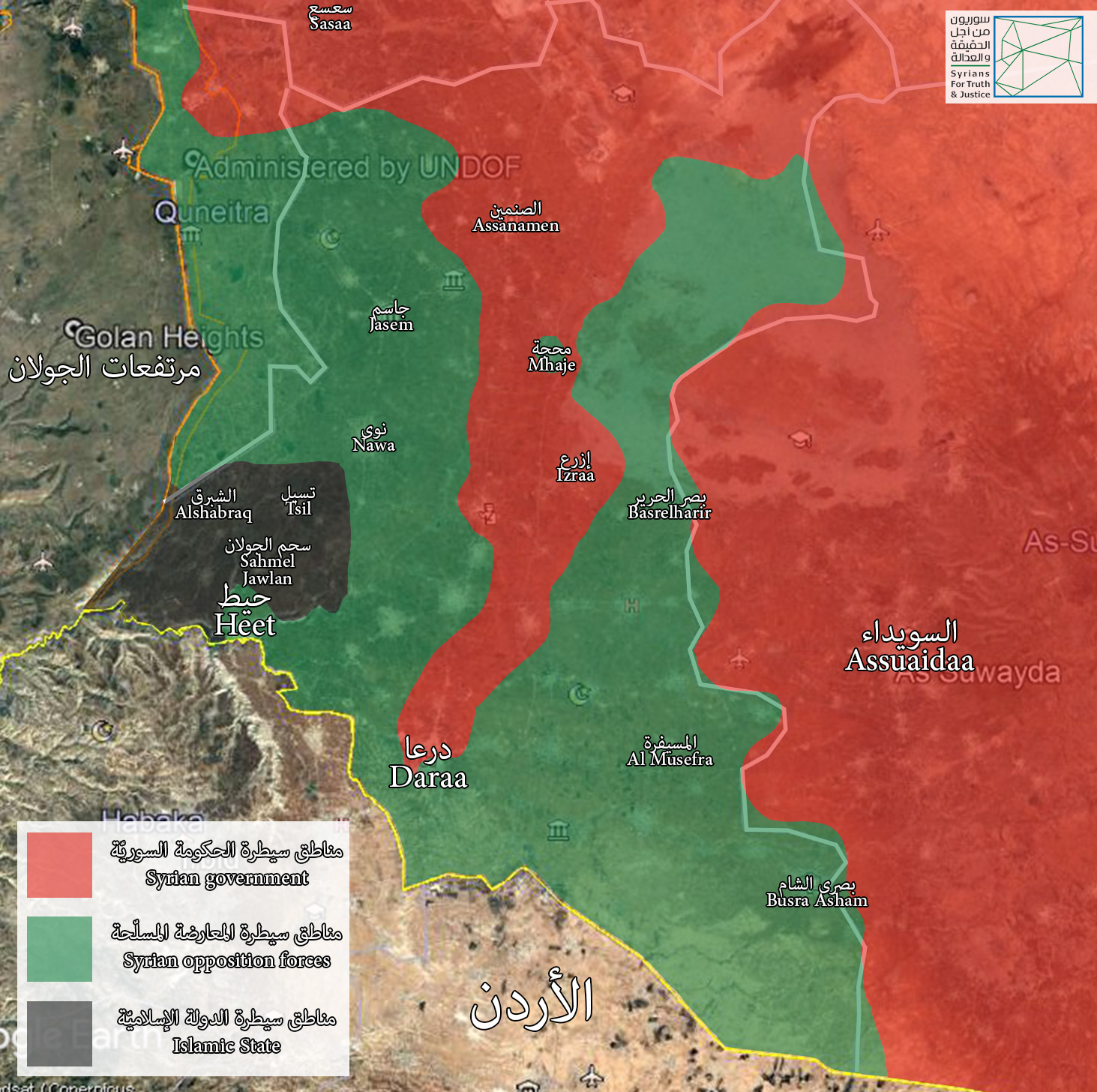
A map illustrates the places of control in Daraa province until March 2018.
First: Russia and the Syrian Regime Threaten of Military Operations in the South
On February 21, 2018, the official Syrian Arab News Agency- SANA , loyal to the Syrian government, said that “Admiral Colette Vadim”, the official of the de-escalation zone in the southern region, held a meeting with members of the National Reconciliation Commission, specifically in the Governorate Building in Daraa. During the meeting, with the representatives of villages and towns of Dae’l, Ibtaa, al-Harak, Nahta among other areas of Daraa province, he discussed ways of pushing forward the national reconciliation process and the steps to be taken to bring back, what he described as “the seduced people to the Motherland". Concerning this, one of the attendees who was present at that meeting, said to STJ:
"The Russian envoy and the Syrian regime threatened to transfer military operations to the southern region after the completion of the Eastern Ghouta file, with the aim of regaining control over armed opposition-held parts if they do not hand over their weapons and surrender peacefully. Vadim demanded the attendees to deliver strong messages to the Free Army factions in Daraa to settle their situation and surrender their weapons before the military attack on the area is decided."
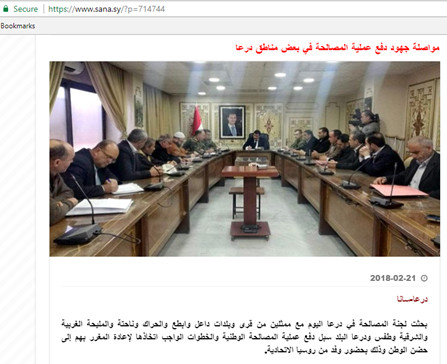
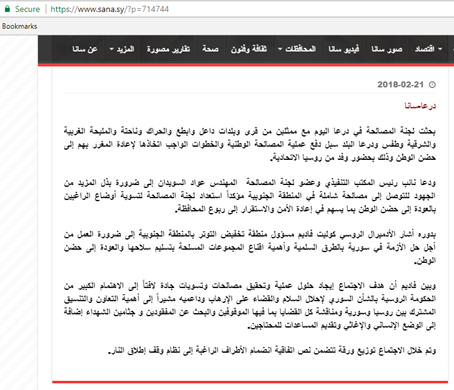
An image shows the news published on February 21, 2018, by the official SANA Agency, loyal to Syrian government, on the meeting held to conduct a reconciliation process in Daraa province.
Photo credit: the official SANA Agency.
On March11, 2018, the Facebook Page of Central Channel of Hememim, the Russian military airbase[3]", published a statement saying that:
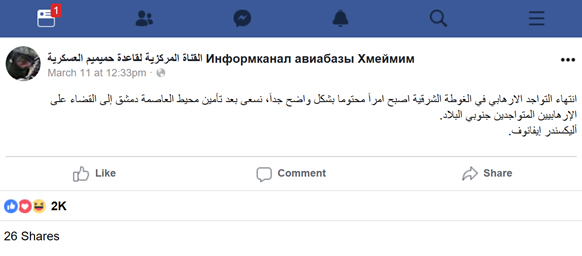
Image shows the declaration of Facebook page of Central Channel of Hememim Military Airbase on March 11, 2018.
Photo credit: Facebook page of Central Channel of Hememim Military Airbase
Second: Syrian Regular Forces Kill and Injure Several Civilians in Daraa Province
Threats of the Syrian regular forces to armed opposition factions in Daraa province were in the form of attacks targeting several areas of the province indiscriminately during February 2018, either using mortar shells, artillery, elephant rockets, rocket launchers or explosive cylinders. According to STJ’s field researcher, on February 21, 2018, the Syrian regular forces commenced a campaign of indiscriminate bombardment on towns and cities of (Western Ghariyah, Eastern Ghariyah, Dae’l, an-Nouaima, Daraa al-Balad, al-Karak, al-Hara city, Busra al-Harir, al-Najyeh’ village, Saida town, Jasim city, al-Mesefra, Nahta, and Elmah town), and caused several civilian casualties. On the first day of that campaign, the Syrian regular forces, stationed in Kherbet Ghazaleh, shelled Dae’l city and caused the death of "Sahar Muhammad Abdel Rahim al-Hariri", in addition to injuring three other civilians. On February 28, 2018, the child "Ibrahim Mohammed Hussein al-Sharif" from Nasib was killed in the shelling of his town. The child, Hamza Ayham Farhan al-Krrad, from Tariq al-Sad was killed as a result of attacks with elephant rockets. On March11, 2018, “Fatima Abdel Majid al-Mafaalani” from Nahta was killed in the shelling by Syrian regular forces stationed in the western countryside of al-Sweida.
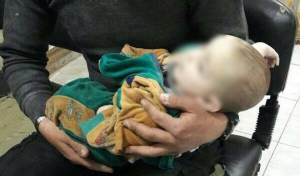
Image of the child "Hamza Ayham al-Krrad", who was killed during bombarding Tariq al-Sad neighborhood in Daraa city on February 28, 2018.
Photo credit: activists from the city.
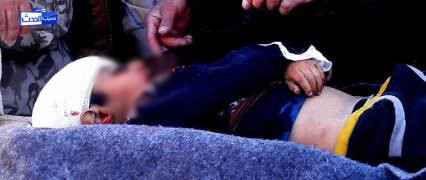
Image of the child "Ibrahim Mohammed Hussein al-Sharif", who was killed in the shelling of Nasib town on February 28, 2018.
Photo credit: Nasib al-Hadath Facebook.
Mahmoud Bakkar, who hails from Dae’l city, was one of the injured in the shelling by Syrian regular forces on February 23, 2018, he said:
"On February 23, 2018, while I was having breakfast with my family, an elephant-type rocket landed on our house. We heard the sound of a powerful explosion and smoke and dust spread everywhere. I thank God because my family and I were in a room far from the strike location. We had only minor wounds, but my son Mahmoud was seriously injured given he was in another room. We immediately dispatched him to the hospital and several fragments that had stabilized in his body were extracted, but a large fragment remained in his spine, and the doctors could not extract it because of its gravity. He is now in a difficult health situation, knowing that I had already lost another son, when the Syrian regime shelled the city two years ago."
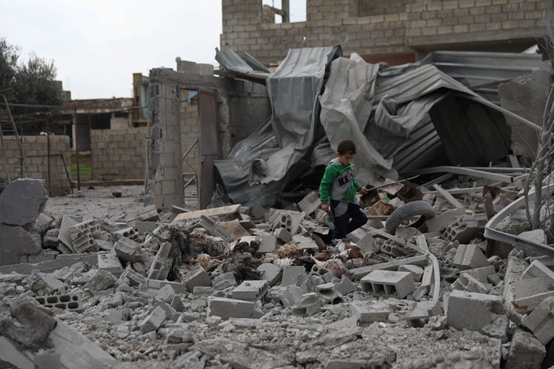

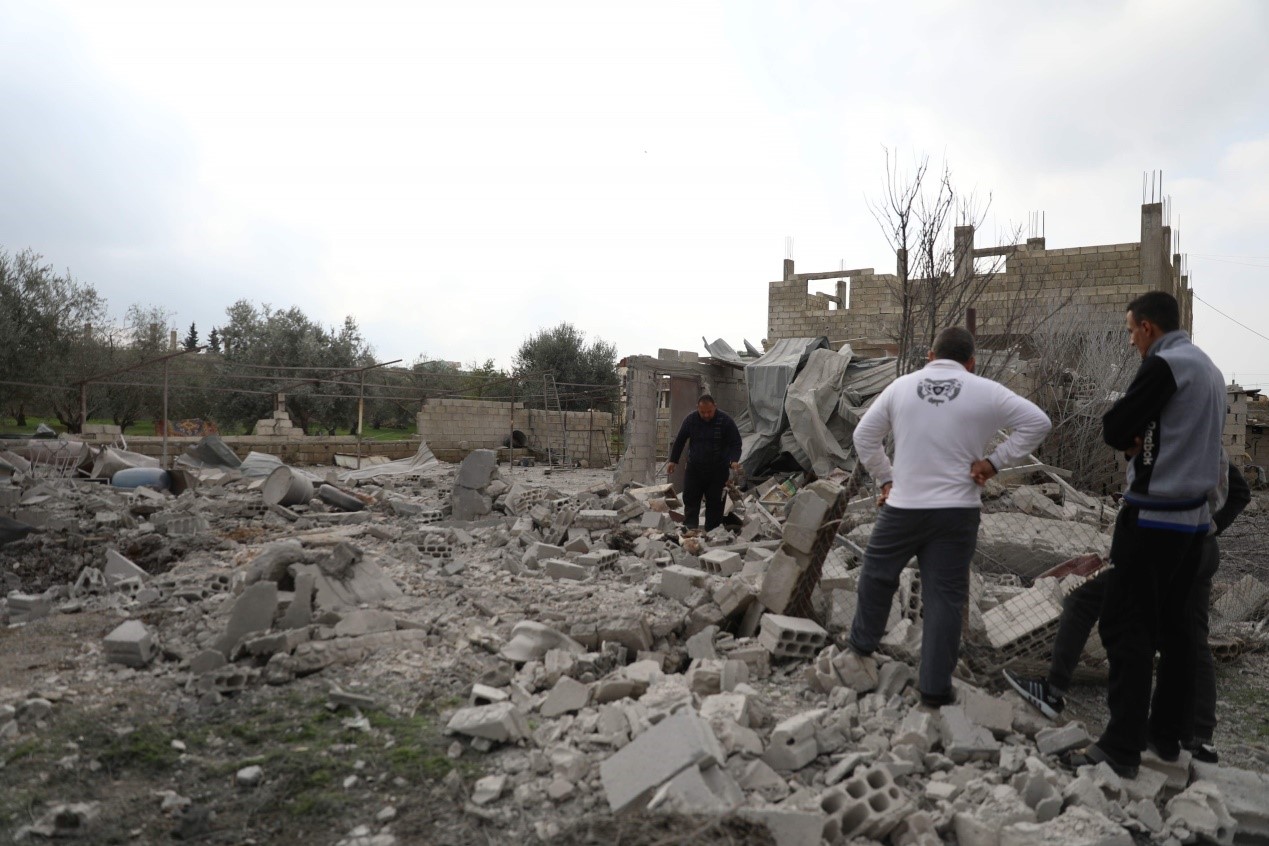
Images show some of the devastation affected to civilian homes in Dae’l in Daraa countryside following the bombardment by Syrian regular forces on February 23, 2018.
Photo credit: STJ
Third: Armed Opposition Groups Respond to Violations Committed by Syrian Regular Forces
In response to Syrian regular forces’ threats, armed Syrian opposition factions launched a campaign of mortar shells and heavy artillery on positions of the Syrian forces in Daraa city, Izraa and Kherbet Ghazaleh. The opposition considered that the Syrian regular forces had not adhered to the de-escalation zone agreement in southern Syria since its first day. In this regard, Abu Bakr al-Hasan, the spokesperson of "Jaysh al-Thawra[4]", one of the largest armed opposition factions in Daraa province, said:
"We have received several messages through delegations and people who held meetings with the Syrian regime and the Russian envoy in Daraa, that the truce would be discontinued during February 2018. There is no doubt that the messages are to practice pressure on the popular incubator in Daraa to intimidate them from a war to come. As for our part, we do not consider such statements as a declaration of war because the de-escalation zone agreement was made between the United States, Russia and Jordan with an unspecified time frame. However, the Syrian regular forces have not adhered to that truce since the beginning, as we have recorded many violations that caused the killing and wounding of many civilians. The on-going violation of the de-escalation zone regime agreement in the southern region by the regime will lead to a complete breakdown of that agreement, hence, all options will be open, including a large-scale battle against Syrian regime forces. In addition to the fact that the opposition's reaction is to target the Syrian regime military areas and barracks which are away from civilian populations."
Fourth: Internal Displacement Waves within Daraa Province
Several cities and towns in the Eastern countryside of Daraa, such as (Busra al-Harir, Melihit al-Atash, and Nahta) witnessed a massive exodus, estimated at hundreds of families, during February 2018. Many civilians left their homes after the increase of Russian threats and talk of attacks that may target their areas by Syrian troops. According to STJ’s field researcher, most of the displaced persons moved to areas close to the Jordanian border such as (al-Karak, Ma’araba, al-Tyba, Mesefra and Busra al-Sham), which are believed to be safer in case of any development. Other families have set up many tents because of the scarcity of the empty houses in those areas.
[1] "Settlement/Reconciliation" term means access to a certain type of agreement with Syrian government forces, which includes different forms of terms, such as lifting the siege, cessation of shelling by the regular army and the introduction of foodstuffs among others. In Syria, the “reconciliation” term varies from region to another, and differs from the term “truce”, or “cessation of hostilities” or “cease-fire”. Sometimes in the Syrian context, it refers to the neutralization of the area and its subordination to the central government in Damascus.
[2] Late 2015, more than 20 armed factions announced formation of the joint operations headquarter under the so-called "al-Bonyan al-Marsous" with the aim of coordinating confrontation against the Syrian Regular army in the eastern neighborhoods of Daraa City. Some of these factions are Ahrar al-Sham al-Islamiyya Movement, Hayat Tahrir al-Sham/HTS, Shabab al-Sunna Forces and Jaysh al-Yarmouk among others.
[3] The page referred to is an unofficial page, and according to many sources, the page is managed by both the Syrian/Russian governments.
[4] It was formed on December 4, 2016, when four military opposition factions merged in Daraa province; they are Jaysh al-Yarmouk, Jaysh al-Mou’taz, Jaysh al-Muhjereen wal Ansar, and al-Hasan Bin Ali Brigade. In late 2018, Liwaa Omar al-Mukhtar joined them.

